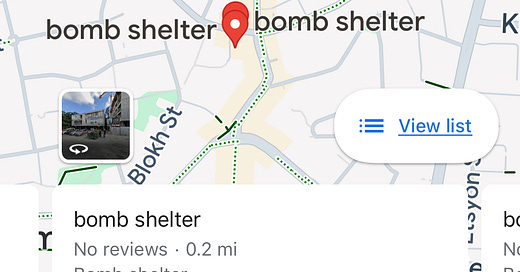Bomb shelters near me
Today marks 100 days since I returned to Israel. Today marks 302 days since the start of the war.
I spent Friday night alone because I am temporarily staying in an apartment in Ramat Gan, a distance from the two synagogues I visit and from new friends in Jaffa and Neve Tzedek. Being alone and not knowing anyone here, I was anxious about a possible attack by Iran that would send me into a bomb shelter a block or two from where I was sleeping.
Newer apartment buildings have a ממ”ד – mamad, an acronym for Merchav Mugan Dirati, a hardened room that can withstand the impact of a missile strike. It is a sealed room that protects against high-impact projectiles and chemical weapons.
My apartment in Yafo had a mama d that was also my bedroom. It felt like I was sleeping in a crypt.
A tomb. Unlike the tombs of Egyptian royalty, painted décor, foods and toys, and household help, everything needed, the mamad is a bleak, hardened space—a vault. The door to the mamad is a heavy iron door which will always open outwards. There must be a concrete wall protecting the door when opened.
Older apartment buildings have bomb shelters in the basement, but the building I am in now doesn’t. I’ve been told that a staircase is relatively safe. I was also told that if sirens sounded, I should run across the street and follow others who would take shelter in a community bomb shelter.
Two weeks before I flew to Israel last April, on the night of April 13/14, Iran (not their deadly proxies, Hamas, Hezbollah, and the Houthis) launched approximately 350 missiles of all kinds, including ballistic and cruise missiles, at Israel. The combined forces of Israel, the United States, Jordan, Britain, and France were able to intercept 99% of the missiles and drones. Tragically, a young Bedouin girl was killed by shrapnel from one of the interceptions, but it was a miracle that no one else died that night.
People react in different ways to these attacks. I have a dear friend, a divorced mother of six children in Jerusalem. For them, it was a terrifying night. Their apartment building shuddered each time an interception occurred in the skies over Jerusalem.
Twice, separated by many years, I woke from nightmares in which an Arab terrorist was holding a knife at my throat. This time, during my first week back in Israel, the Arab man was a stereotype of a bloodthirsty terrorist. He held a glistening scimitar at my throat. A stereotype? The Hamas terrorists that invaded the kibbutzim near Gaza were 21st-century sadistic, Go-Pro-wielding torturers beyond anything I have met in my nightmares.
In greater Tel Aviv, I don’t visualize someone holding me at knife’s edge. I worry about being in a crowded bomb shelter and unable to understand what is being said.
On Shabbat, there are no trains or buses. On Saturday morning, I biked to my Neve Tzedek synagogue. It’s only about a 30-minute ride, but like every day for weeks, the heat index was above 100 degrees. The humidity is paralyzing. I was glad to be together with other people for Shabbat services. Toward the end of services, the rabbi asked us, “How many of you slept well last night?” His question and the responses around me let me know that I was far from alone being worried Friday night.
I was invited by a new friend and his wife to have a leisurely lunch with friends of theirs. People made guesses about when Iran will attack. A couple of people said tonight. Someone else said tomorrow. Another said Tuesday.
Now, it is Saturday night, after 10 o’clock. I feel anxious as I put together a ‘to go’ bag to grab if sirens sound tonight. What should I bring? A toothbrush? A phone charger? A book? What else? I don’t have much food on hand. How long might I have to be in the bomb shelter? But life goes on. I have homework due at 9:00 a.m. for my ulpan class. So – absent an attack and a night in a bomb shelter, I will do my homework.




